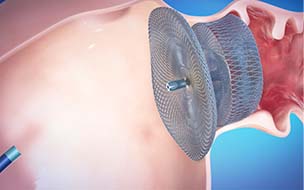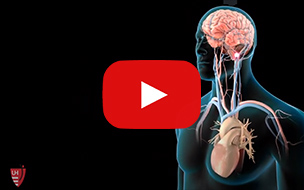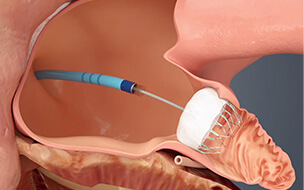Left Atrial Appendage Closure: An Alternative to Blood Thinners for Some Patients with AFib
The left atrial appendage (LAA) is a small, pouch-like sac in the top left chamber of the heart. It is where more than 90 percent of stroke-causing clots are formed. Closing the pouch prevents blood clots that may form there from entering the blood stream, traveling to the brain and causing stroke. LAA closure permanently closes the pouch and offers a lifetime alternative to blood thinning medications to prevent stroke in patients with AFib.
Your heart health is important. Don’t delay care.
Call 216-844-8448 to schedule an appointment with a UH doctor specially trained to perform left atrial appendage closure procedures.
Find a Doctor
How is the LAA Closure Procedure Done?
Patients are put under “twilight” anesthesia for this minimally invasive, catheter-delivered procedure. The doctor inserts the delivery catheter (thin, flexible tube) into the body through a vein in the leg and, using advanced imaging-guidance, directs it to the upper right chamber of the heart. The catheter is then carefully advanced through the wall (septum) that separates the two upper chambers of the heart (atria) and positioned in the left atrium.
The device is advanced into the left atrial appendage where it opens up like an umbrella to block the opening of the left atrial appendage. After the device is released, heart tissue grows over it, permanently sealing off the appendage and preventing blood from reaching that area.
Devices That We Use
There are two FDA-approved devices that our specialists typically use for this procedure. Your doctor will select the device that best meets your needs. The devices include:
- WATCHMAN FLX™ Left Atrial Appendage Closure Implant
- Amplatzer™ Amulet device
There is a third minimally invasive surgical option that may be used in people with unique anatomy or those who are not candidates for a percutaneous approach. For these patients, our surgeons may choose to use a device called an AtriClip, an FDA-approved clip that is placed over the left atrial appendage through a small incision between the ribs. The AtriClip procedure requires general anesthesia.
Regardless of the device used, LAA closure procedures are minimally invasive and highly effective in preventing stroke in patients with atrial fibrillation.
Who is Eligible for LAA Closure?
To be eligible for this treatment option, patients must meet all three of the following criteria:
- Have atrial fibrillation unrelated to a heart valve problem
- Be at increased risk for stroke
- Have reason to consider an alternative to blood thinners for stroke prevention. Ideal candidates often have a history of bleeding while taking blood thinners or have a medical condition, occupation or lifestyle that puts them at increased risk for bleeding
Safety and Benefits of LAA Closure
For eligible patients, LAA closure is a very safe procedure that offers many benefits, including:
- Less invasive than open heart surgery
- Faster recovery - most patients may go home on the same day as procedure
- Permanently reduces the chance of blood clots in the heart
- After the procedure, patients are able to stop taking blood thinners





